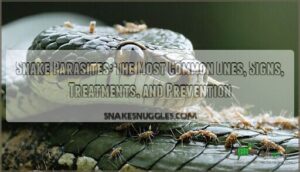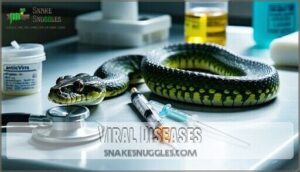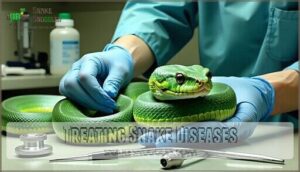This site is supported by our readers. We may earn a commission, at no cost to you, if you purchase through links.

These microscopic threats—ranging from Cryptosporidium to nematodes—don’t announce themselves with obvious symptoms until significant damage has occurred. Understanding which parasites strike most frequently, how they manifest, and what treatments actually work can mean the difference between a routine veterinary visit and a life-threatening emergency that forces you to make difficult decisions about your snake’s future.
Table Of Contents
- Key Takeaways
- Common Parasites in Snakes
- Recognizing Snake Illness
- Treating Snake Diseases
- Inclusion Body Disease (IBD)
- Preventing Snake Diseases
- Frequently Asked Questions (FAQs)
- How do I recognize if my pet snake is shedding or if it has a skin infection?
- Can snake parasites be transmitted to humans or other pets in the household?
- What should I do if I find ticks or mites on my pet snake?
- Can snakes transmit parasites to humans directly?
- How often should fecal exams be performed?
- What parasites affect wild versus captive snakes?
- Are certain snake species more parasite-resistant?
- How do mites spread between snake collections?
- Conclusion
Key Takeaways
- Over 17% of captive snakes harbor intestinal parasites, with Cryptosporidium affecting more than a quarter of tested snakes, making regular fecal examinations and immediate quarantine of new arrivals (minimum 30 days) essential for preventing facility-wide outbreaks.
- Early detection is critical because most parasitic infections—from nematodes to snake mites (Ophionyssus natricis)—produce subtle behavioral changes like food refusal, lethargy, or face rubbing before visible symptoms appear, turning routine care into life-threatening emergencies if ignored.
- Inclusion Body Disease (IBD) has no cure and often requires euthanasia, underscoring why prevention through strict quarantine protocols, proper enclosure hygiene, and routine veterinary checkups matters more than any treatment option currently available.
- Effective parasite control demands both environmental management (dichlorvos strips, permethrin sprays every 7-10 days, proper humidity and temperature gradients) and medical intervention (targeted deworming, antibiotic therapy), with zoonotic risks like Cryptosporidium and Salmonella requiring rigorous handwashing to protect household members.
Common Parasites in Snakes
Snakes can pick up a range of parasites, just like any other animal. Some of these cause subtle problems while others make themselves known right away.
Here’s a rundown of the most common types you’ll want to watch for.
Mouth Rot
If you’ve ever wondered why your snake seems a bit off, mouth rot might be the hidden culprit lurking just out of sight. Infectious stomatitis, often called mouth rot, spreads rapidly among snakes. Bacterial invasion causes pinpoint hemorrhages, a thick, foul-smelling mucus, and swollen gums. Left unchecked, complications can escalate fast—think tissue damage or even death. Oral antibiotics are the preferred treatment, but prevention hinges on clean habitats. Recognizing symptoms early makes all the difference:
- Bleeding or swollen gums
- Thick, cheesy mouth discharge
- Loss of appetite
- Foul oral odor
- Visible oral lesions
Intestinal and Skin Parasites
After noticing mouth issues, you might also see subtle threats from intestinal and skin parasites. Nematode prevalence is common—over 17% of snake samples show infestation, with symptoms like diarrhea or weight loss. Cryptosporidium detection is especially high in wild and pet snakes, affecting over a quarter tested. Add in Ophionyssus natricis mites, and you’re facing real challenges. Regular fecal examination, targeted deworming medications, and solid parasite control keep your snake healthy. One such issue involves ectoparasites like mites, which are distributed worldwide and can affect most reptilian species.
| Parasite Type | Prevalence | Key Prevention Tip |
|---|---|---|
| Nematodes | 17.4% | Fecal Examination |
| Cryptosporidium spp. | 26.1% | Quarantine New Snakes |
| Cestode Infections | 0.9% | Deworming Medications |
| O. natricis (mites) | Globally widespread | Parasite Control |
| Secondary Pathogens | Often via mites | Clean Enclosure |
Skin Infections
Just as intestinal and skin parasites can slip under your radar, skin infections can also sneak up on your snake, quietly turning healthy scales into trouble spots. You might start with a subtle patch of redness, but it can quickly progress. Bacterial Dermatitis, Fungal Infections, and classic culprits like Scale Rot or Blister Disease often stem from too much moisture or dirty enclosures—prime real estate for mites and ticks.
Watch for excessive shedding, open sores, or lethargy. Early detection and prompt skin infection treatment spare your snake from more severe issues, such as abscesses or deeper tissue problems. The best defense? Regular inspections, solid hygiene, and swift Abscess Treatment at the first sign of infection.
Respiratory Diseases
Once your snake’s skin is in the clear, don’t let your guard down—respiratory diseases can sneak in next, and they’re often more serious than they first appear. Watch closely for pneumonic signs: snakes with excess mucus, open-mouthed breathing, or sluggish movement may be struggling with pneumonia types or even fungal infections.
Common culprits and challenges include:
- Antibiotic resistance making treatment tough
- Nebulization therapy as a promising approach
- Aspiration risk from improper feeding or enclosure conditions
- Respiratory parasites in reptiles complicating recovery
Prompt care is essential because these infections escalate quickly.
Viral Diseases
When a virus gets in the mix, you’re looking at a whole new set of challenges that can turn your snake’s health upside down in a hurry. Viral diseases in snakes can range from mysterious paralysis to unpredictable digestive flare-ups, thanks to emerging viruses and stubborn IBD variants like Inclusion Body Disease.
Even with an immune response, many snakes have limited defenses against viral transmission. Antiviral options are sparse, so your best bet for preventing Inclusion Body Disease and other viral infections is quarantine, routine check-ups, and, when possible, consulting your vet on recent vaccines.
Recognizing Snake Illness
Spotting illness early in your snake can make all the difference in treatment and recovery. There are a few clear signs worth watching closely. Here’s what you need to keep an eye out for next.
Specific Signs
If you ever spot an unusual change, don’t brush it off—specific signs can speak volumes about your snake’s health. Clinical signs like cheesy discharge, thick mucus, or pinpoint hemorrhages signal oral lesions and severe infections. Watch for:
- Bloody or thick oral mucus
- Skin blistering or irritation (cutaneous signs)
- Excess nasal mucus or discharge (respiratory signs)
Spotting these early can save lives; intestinal parasites can also cause breathing issues.
Non-specific Signs
It’s easy to overlook the little things, but sometimes a sluggish appetite or a hint of laziness is your first clue that something deeper is brewing beneath those scales. Appetite changes, lethargy, unusual hiding behavior, or unexplained weight loss aren’t just quirks—they often signal parasites or illnesses.
Notice fluctuations or shedding issues? These subtle behavioral changes in snakes deserve prompt attention.
Mites and Ticks
Have you ever noticed how a tiny hitchhiker can cause a world of trouble under those scales? Mites and ticks infestation isn’t just an itchy inconvenience—it can transmit tickborne diseases and upset your snake’s health rapidly.
Recognizing ectoparasite infestations in reptiles starts with careful mite identification and understanding their lifecycle, which are key to effective snake mite control and preventing infestations altogether.
Behavioral Changes
Sometimes, the first clue that something’s wrong slithers in quietly—changes in your pet’s habits often speak louder than any visible symptom. If you notice a drop in activity levels, unexpected hiding behavior, or decreased social interaction, take these clinical signs seriously. Appetite changes and rapid weight loss can hint at parasites or illness.
Shedding issues paired with lethargy and appetite decline deserve prompt attention, since subtle shifts often foreshadow significant health concerns.
- Shedding issues paired with lethargy and appetite decline deserve prompt attention, since subtle shifts often foreshadow significant health concerns.
Treating Snake Diseases
When your snake gets sick, knowing what to do next can feel overwhelming. Each type of illness calls for its own approach and set of treatments.
Here’s what you need to know about the main methods for treating common snake diseases.
Stomatitis Treatment
Dealing with mouth rot in your snake isn’t just a quick rinse—think of it as a battle that calls for both vigilance and a veterinarian’s expertise. Your vet may recommend:
- Oral antibiotics and topical therapy for acute stomatitis relief
- Professional wound care and gentle mouth rinsing to clear debris
- Nutritional support, pain management, and strategies to prevent recurrence
Prompt treatment is essential for true recovery.
Parasitic Infections Treatment
When routine care for mouth rot is done, your next challenge is parasite treatment. Deworming medications and anthelmintic drugs are specific to the particular invader—think nematodes or protozoa—while ectoparasite control knocks back mites and ticks.
For tough cases, venom therapies or new anthelmintic therapy may help. Monitor prevalence and adjust antiparasitic medications based on your vet’s advice.
Skin Infections Treatment
Once you’ve tackled parasites, turning your attention to skin infections keeps your snake one step ahead of trouble. Effective treatment always starts with clean, dry quarters—think of this as the first domino in preventing recurrence. Topical medications, such as medicated baths or antifungal treatments, work at the source of skin infections, while antibiotic options—oral, injectable, or topical—address deeper bacterial concerns. Regular wound care and antiparasitic medications also matter.
Three essentials for healthy recovery:
- Disinfect enclosures and hands before interacting.
- Apply veterinarian-prescribed topical therapy and antibiotics.
- Schedule prompt checkups to catch problems early.
Always consult your veterinarian for specialized treatment.
Respiratory Infections Treatment
When your snake starts showing signs of respiratory trouble, you’ll need to act quickly and thoughtfully to support their recovery. Nebulization therapy and targeted antibiotic choices, guided by your veterinarian, form the core of respiratory infection treatment.
Alongside antibiotics, supportive care, humidity control, and prompt action prevent pneumonia. Regular checkups help you tackle respiratory infections in snakes before things spiral out of control.
Septicemia Treatment
Catching infections early is important, but septicemia brings a new sense of urgency, demanding quick, hands-on care for your snake’s best shot at recovery. Your veterinarian will step in with rapid Antibiotic Selection, attacking infection while also using Fluid Therapy to correct dehydration.
Supportive Care makes a huge impact—think warm, calm, humidity-controlled space. Sometimes, critical cases may need Blood Transfusions for rebuilding strength.
Remember, Prognosis Factors—how early you intervene, your snake’s underlying health, and the chosen antibiotics—matter as much as the treatment plan itself.
- Antibiotic Selection and administration
- Fluid Therapy and electrolyte balance
- Supportive Care with warmth and humidity
- Blood Transfusions when needed
- Monitor Prognosis Factors and recovery
Inclusion Body Disease (IBD)
Inclusion Body Disease, or IBD, is a serious viral infection that can affect many snake species. It’s important to know what to watch for and how to respond if your snake is at risk.
Let’s look at what you need to know about IBD in your enclosure choices.
Symptoms
Think your snake’s acting strange? Inclusion Body Disease (IBD) turns subtle changes into red flags. Watch for:
- Sudden paralysis or twitching—hallmarks of neurologic distress
- Open-mouthed breathing or wheezing, signaling respiratory distress and potential viral threat
- Trouble digesting meals, often paired with dramatic weight loss
These clinical signs—especially behavioral changes and skin abnormalities—signal a disease that demands immediate attention.
Treatment
Alongside every diagnosis, you’re faced with choices that test your resolve and remind you that prevention starts long before symptoms appear. When confronting IBD, euthanasia is often the kindest route, as no cure exists.
For other diseases, your veterinarian may recommend targeted therapies—antiparasitics for intestinal and skin parasites, antibiotic therapy or antifungal meds for infections, and topical or surgical options when necessary. Supportive care—hydration, warmth, stress reduction—remains essential throughout any treatment.
Prevention
Even the smallest habit you change today can be the thread that weaves a healthier, safer future for every snake in your care. Start with strict quarantine protocols, insisting on separation and close observation with every new arrival.
Small habits today—strict quarantine, close observation—weave a healthier, safer future for every snake in your care
Build in hygiene practices—handwashing and cage cleaning—as your daily ritual. Pair these with routine vet checkups, regular fecal exams, and strategic deworming schedules.
Together, these steps anchor real parasite control, preventing disease transmission before it ever begins.
Preventing Snake Diseases
Staying ahead of snake diseases starts with the right setup and smart routines. The good news is, a few focused steps can make a world of difference for your pet’s health.
Let’s look at the core strategies that belong in every keeper’s toolkit.
Quarantine
Bringing home a new snake might feel exciting, but skipping quarantine is like leaving your front door wide open to trouble. Isolation protocols help protect your established reptiles from hidden threats, especially when snake origins are unclear. A minimum quarantine duration of 30 days gives you time to catch signs of illness, reduce stress, and guarantee a proper enclosure setup. Quarantine protocols for snakes aren’t just good practice—they’re your first defense against preventing parasite transmission.
- Isolate new arrivals in a separate, escape-proof enclosure
- Use dedicated tools and utensils
- Observe for subtle changes in appetite or behavior
Proper Environment
You wouldn’t build a house on a shaky foundation, so why let your snake live in anything less than a healthy, well-kept home? Nailing the proper environment for snakes means dialing in environmental factors—think: thermal gradient, humidity levels, and enclosure size.
Good substrate choice, reliable hiding places, and consistent enclosure hygiene all tighten the net against parasites. Parasite control for snakes really begins with simple, daily snake parasite prevention habits.
| Element | Snake Health Impact |
|---|---|
| Thermal Gradient | Aids digestion, prevents stress |
| Humidity Levels | Fights respiratory issues |
| Substrate Choice | Reduces parasite risk |
| Enclosure Hygiene | Stops waste, hinders parasites |
Regular Check-ups
A vet visit isn’t just a checkup—it’s your frontline defense against parasites that can quietly wreak havoc on your snake’s health. Veterinary expertise guarantees early detection through fecal samples and thorough physical exams, catching infections before they escalate. Regular checkups for snakes—usually annual or biannual, depending on your snake’s age and health history—provide essential health monitoring that you can’t replicate at home.
During these visits, your vet performs:
- Fecal checks to identify intestinal parasites like nematodes or protozoa
- Parasite identification and diagnosis using microscopy and specialized testing
- Preventative care recommendations designed to your snake’s species and environment
This veterinary care approach gives you the checkup frequency and parasite screening your snake needs to thrive, not just survive.
Parasite Control
Beyond regular vet visits, parasite control demands a multi-layered strategy that targets both your snake and its environment. Environmental control matters as much as medical intervention—dichlorvos strips and permethrin sprays eliminate mites in vivariums when applied every 7–10 days.
Your preventative screening approach should include:
- Quarantine protocols lasting at least 30 days for new arrivals, paired with prophylactic treatment to block disease introduction
- Annual fecal examinations to detect intestinal parasites early, preventing drug resistance through targeted deworming schedules
Understanding zoonotic risks protects both you and your snake, making proper hygiene non-negotiable for effective treatment and management of reptile parasites.
Frequently Asked Questions (FAQs)
How do I recognize if my pet snake is shedding or if it has a skin infection?
Distinguishing between normal shedding and infection requires close observation. During shedding, your snake’s eyes cloud over milky-blue, and its skin appears dull.
If you spot red, inflamed patches, blister-like lesions, or excessive mucus, you’re likely dealing with a skin infection that needs veterinary attention immediately.
Can snake parasites be transmitted to humans or other pets in the household?
Parasite transmission poses real concerns for household safety. Reptiles harbor zoonotic parasites—including Cryptosporidium, Salmonella, and pentastomids—that can infect humans and other pets through direct contact or contaminated surfaces.
Regular handwashing after touching your snake, maintaining strict hygiene practices, and scheduling veterinary check-ups greatly reduce zoonotic risks and protect everyone in your home.
What should I do if I find ticks or mites on my pet snake?
If mites or ticks decide to throw a house party on your snake, isolate the affected animal immediately and contact a veterinarian for proper mite identification and tick removal.
Clean the enclosure thoroughly to prevent re-infestation, as these ectoparasites won’t leave voluntarily. Your veterinarian will recommend appropriate topical therapy.
Can snakes transmit parasites to humans directly?
Direct transmission occurs when snakes harbor zoonotic parasites like Cryptosporidium or Salmonella.
Interacting with infected reptiles without proper hygiene creates zoonotic risks, as these pathogens transfer through contact with skin, feces, or contaminated surfaces, highlighting public health concerns tied to exotic pets.
How often should fecal exams be performed?
Fecal examinations should be performed at least annually for healthy adult snakes, though species-specific needs, age considerations, and environmental risks may warrant more frequent testing.
Young snakes and those with exposure to potential parasites benefit from semi-annual exams to guarantee early parasite identification and diagnosis, supporting best veterinary care.
What parasites affect wild versus captive snakes?
Wild snakes commonly harbor ectoparasites like ticks and diverse internal parasites acquired through natural prey consumption. In contrast, captive snake parasites, particularly Ophionyssus natricis mites, spread rapidly in enclosed environments.
Transmission differences stem from environment impact, with captive reptiles facing concentrated parasite burdens. Despite preventative measures, these efforts primarily reduce zoonotic parasites.
Are certain snake species more parasite-resistant?
Some species wield their immune systems like shields, forged through millennia of coevolution dynamics with parasites. Genetic factors and environmental adaptation shape immune response strength, while microbiome influence affects parasite burdens.
Though husbandry practices ultimately matter more than species-level resistance for captive reptile health.
How do mites spread between snake collections?
Ophionyssus mites spread through direct contact between snakes, shared equipment like hides or water bowls, contaminated substrates, and even on your hands or clothing.
Cross-contamination happens fast—mites crawl between enclosures if they’re close together, making quarantine efficacy critical for disease transmission control and environmental control essential.
Conclusion
Your vigilance today shapes your snake’s tomorrow. When you spot the subtle warnings—missed meals, unusual behavior, or physical changes—you’re already ahead of most keepers who wait too long.
Snake parasites, the most common ones, don’t require panic, but they demand respect and swift action. Quarantine new arrivals, maintain proper husbandry, and partner with an experienced reptile veterinarian.
These aren’t burdensome tasks; they’re the difference between thriving animals and preventable tragedy. Your commitment to proactive care guarantees your collection remains healthy for years to come.
- https://www.sciencedirect.com/science/article/pii/S2213224425000045
- https://pmc.ncbi.nlm.nih.gov/articles/PMC12483421/
- https://www.scielo.br/j/rbpv/a/JFjzWJY8NFTpZTnp38S7KRQ/
- https://www.parahostdis.org/m/journal/view.php?number=2042
- https://journals.plos.org/plosone/article?id=10.1371%2Fjournal.pone.0143718















